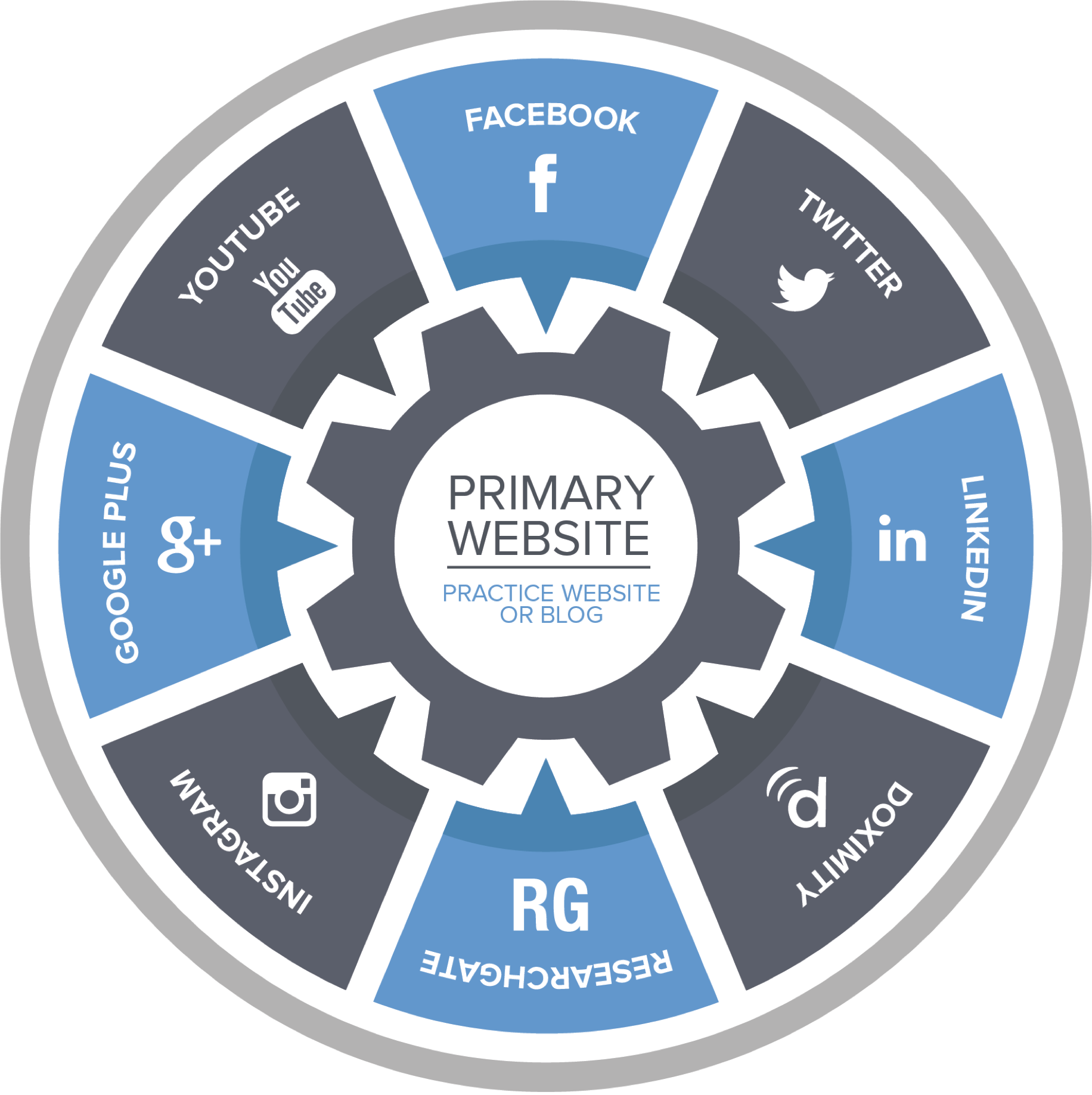Today I would like to talk for a few minutes about how you can use social media and blogging as building blocks for the medical practice and business of the future. This is a talk I originally gave in September 2015 at the Millennial Eye Live meeting in Hollywood, California. My comments were primarily tailored to the audience of young and mid career ophthalmologists, but I believe these same concepts are applicable to physicians in all specialties.
Take a look at this figure which helps explain my approach to professional social media networking. At the hub of the wheel is your primary website. For most of you this is your practice website. On the outside of the wheel are what I consider to be the primary social media tools which physicians should consider using right now. Any content that you create online should be shared on these social media networks to disseminate the information and similarly, your social networks, similarly, should include links back to your primary website.
In order to better understand how young physicians are using social media, I analyzed the online presence of 50 ophthalmologists attending the Millennial Eye Live meeting. 92% of those individuals analyzed have an online professional profile, typically located on their practice or university website. Based on what I could find from their profiles, 72% are in private practice and 28% are in academics.
As you know, the largest social network right now is Facebook. 70% of the 50 ophthalmologists I analyzed have a professional Facebook presence. This presence may be an individual private practice or ophthalmology department Facebook page or it may be a larger hospital network’s Facebook page such as The Mayo Clinic. This is an important distinction, because the larger the organization, the less control you as an individual physician have of the content being shared. Fifty percent of those physicians who claim to have a Facebook presence have at least some control of the content, compared to the 20% that only have a Facebook presence due to their affiliation with a larger organization, and that piggyback on this organizational presence where they unfortunately have little control of the content. When it comes to Facebook and social media in general, I believe it is much more important to be in the 50% that control the content versus the 20% who must simply hope that their individual efforts will be noticed and shared by the marketing or PR team who manage the large organization social media accounts. Having a practice or individual physician-based Facebook page allows physicians to be able to maintain control of the content shared via social media.
What about Twitter? 60% of the ophthalmologists I analyzed have either a personal or practice Twitter presence over which they control, at least to some degree, the content being shared as i just mentioned.
Creating and sharing high quality content online is, I believe, one of the keys to developing a strong online presence. One way to share this content is via a professional blog. I use the term blog quite liberally, as I consider a blog to be a website or page within a website where content can be shared in the form of articles, videos, or other short updates. Using these criteria, 38% of the young to mid-career ophthalmologists that were present at the meeting have some type of professional blog. 22% do NOT have a blog, but could VERY VERY easily add a blog to their website by simply adding an additional page to their already-existing practice website. An additional 20% don’t have a blog but might face additional challenges in starting a blog than those in private practice who can simply start a blog by adding a page to their already-existing website. The final 20% do not have any website which I consider to be easily-suited for a blog. Having a blog is an important key to developing an online presence, as posting regular updates shows Google that your site is dynamic and interesting, improves search engine rankings, and provides a digital home to which the traffic generated via the various social media tools can be redirected, which further generates traffic to your website.
So what types of content should physicians consider posting on their personal or practice blog? I like to think of content as falling into these five categories, advertising, office news, current events, presentations, and publications. Now here is perhaps the most important point to remember from this entire discussion. You, my physician colleagues, are already doing ALL of these things! You advertise, at least in some form, in order to attract new patients, you certainly have new office staff and participate in the community, you are aware of current events related to your field and could publish your professional opinion regarding these events, you often travel to medical conferences to give presentations and for continuing medical education, and you may even contribute to peer-reviewed articles, invited editorial publications, guest lectures in the community, or even interviews with local news media. These are all activities you are already doing, and will continue doing, whether or not you share them online. You simply need to start sharing the content you are working so hard to create! As you share this content online, you will fill your office with patients that are familiar with your work, understand your areas of expertise, ask good questions, and are engaged in their health.
Finally, let me show you an example of how I recently used a few of the concepts I have just described. You may remember “The Dress” fiasco a few months ago. Seemingly overnight, everyone in the world was arguing about the color of the dress. Was it black and blue or gold and white? The internet was buzzing and the public everywhere wanted to know why the dress appeared to be different colors to different people. Recognizing that this was an opportunity to educate the public on the fascinating phenomenon known as the Purkinje effect, I asked one of my colleagues to write an article describing this effect and how it helped explain the color of the dress. I posted this article to my site, and also to my social media channels, and within an hour had received an email from Kevin Pho, founder of KevinMD.com, asking to cross-post my article to his site. Over the next three days, the article had been shared nearly 4000 times via Twitter and Facebook and had over 40,000 views, which created a considerable spike in the traffic to my site and hopefully helped others learn more about their vision and ophthalmology. Finally, I’d like to invite you to join with me in sharing high quality content online via blogging and social media.
Let's Get Social: A #Physician Guide to #SocialMedia and #Blogging Click To Tweet










